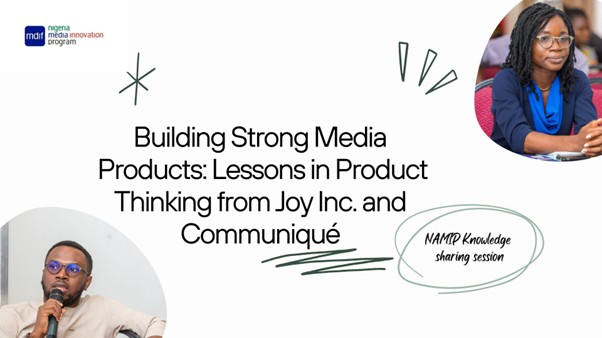By Temitayo Akinyemi
Product development in media isn’t just about creativity—it’s about purpose, process, and precision, participants explored how product thinking is shaping some of Nigeria’s most innovative media efforts. Dorcas Taiwo, Product Lead at Joy Inc., and David Adeleke, Founder of Communiqué, offered a powerful masterclass that described how they approach building products that audiences love—and pay for.
This article summarizes their key lessons for the broader media ecosystem, especially for organizations navigating content strategy, audience engagement, and monetization in a challenging economic landscape.
The Power of Product Thinking – Insights from Communiqué
Why Product Thinking Matters
David Adeleke opened the session with a bold declaration: media products must be built with a product mindset—intentional, research-driven, and audience-centric.
“We often build media products based on what we think people need. Product thinking challenges us to ask what people already use, pay for, and engage with.”
Key Reasons Why Product Thinking is Crucial:
- Build What People Actually Want:
Avoid assumptions. Use real-world user research to uncover what your audience already consumes and what gaps exist in their experience. - Ensure Commercial Viability:
Ask: what have people paid for in the past? This question is more revealing than what they say they would pay for. By following what people have done, you can better predict what they will do. - Develop Reusable Frameworks:
A product approach provides processes that can be repeated and refined—helping media teams scale what works and avoid what doesn’t.
How Communiqué Builds Its Products
Inspired by Walt Disney’s “synergy map,” Communiqué uses a knowledge ecosystem model. At the core is the question: “How do people interested in the creative economy learn?”
Product categories in their ecosystem include:
- Newsletters
- Events
- Research
- Videos
- Data products
- Investment opportunities
Each product is designed not in isolation, but as part of an interconnected strategy to deliver value across multiple audience needs and formats.
User Research: Moving Beyond Guesswork
David emphasized that media products often fail because of a lack of structured user feedback. His approach includes:
- Annual Audience Surveys
- One-on-One Conversations with Paid Subscribers
- Feedback Loops via Newsletters
When users engage, David’s team listens—especially when they cancel subscriptions, as these insights reveal friction points that often guide product improvement.
Purpose-Driven Product Vision – Lessons from Joy Inc.
Dorcas Taiwo of Joy Inc. brought a different perspective—one rooted in behaviour change and emotional transformation.
“Our work at Joy Inc. is about creating media that strengthens the mind, the heart, and the spirit. And we do this by telling stories that matter.”
The #WithChude Model: Grow, Engage, Monetize
Dorcas shared how #WithChude (which includes podcasts, documentaries, devotionals, newsletters, and more) grew from a personal pain point—a need for meaningful, emotionally intelligent media—and evolved into a product ecosystem through a deliberate process:
- Start with Pain:
Identify a personal or observed problem in the ecosystem—what’s broken? What’s missing? - Do the Research:
Understand the landscape. Has someone else tried and failed? Why? Is there global demand for something similar? - Question Assumptions:
Challenge common myths. For instance:- “People don’t pay for media”
- “Nigerians only consume humorous content”
- “Documentaries don’t go viral”
- Build Small and Test:
Launch pilots. Use real feedback to evaluate success or failure. Iterate based on actual data, not instinct alone. - Be Honest About What’s Working:
If a product flops, shut it down. If it works, replicate the success with the right metrics and timeline.
Practical Tips for Newsrooms Doing Audience Research
In Nigeria’s context—where in-depth user data is hard to come by—both speakers offered practical advice:
- Don’t Rely on Idealistic Questions:
Ask users what they already do, not what they wish to do. - Use Incentives (Wisely):
As Dorcas noted, incentives help increase response rates, especially for interviews or feedback sessions. - Talk to Leavers, Not Just Loyalists:
People who unsubscribe or disengage often offer the most honest—and helpful—insights.
Key Takeaways
- Product thinking helps media organizations align creative vision with market realities.
- User research should prioritize observed behaviours over stated preferences.
- Media innovation is possible even with behaviour-change content—if guided by strategy, empathy, and iteration.
- Feedback should be continuous, intentional, and structured—even if the budget is small.
Conclusion
Dorcas and David reminded participants that media products don’t just “happen”—they’re built. Thoughtfully. Iteratively. Strategically. Whether you’re building a newsletter, launching a video series, or testing out events, the path to success lies in combining empathy and passion with data, vision with feedback, and creativity with process.
For NAMIP participants and the broader Nigerian media ecosystem, these lessons offer a practical blueprint for designing audience-first, resilient, and purpose-driven media products.
*a version of this article was improved using ChatGPT.

